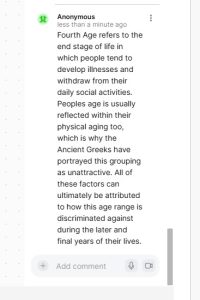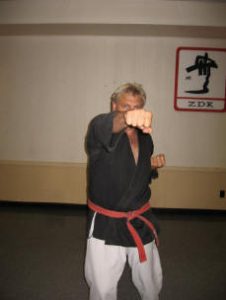6 Chapter 6 (Completed)
Padlet Responses:



Notebook Responses:
What does the article (referencing another study by Dionigi) mean by its statement that sport can help aging people to simultaneously “accept and resist the ageing process” (572)? Find two images online and paste them into your notebook showing how sport might help aging people to both accept and resist the aging process.
It means that through playing sports, older athletes have the opportunity to accept that as they age their physical abilities gradually decline. This can be because they experience more difficulty in mobility, speed or breathing, which can be impacted by age. Through sports elderly people are forced to accept the reality that their bodies are bound to be less able than when they were younger.
They may accept that their abilities have changed over the years by adopting a new sport that is less physically demanding. For example in the selected image, ping pong. Another example could be water aerobics.

On the other hand, through playing sports elders have the option to reduce the physical effects of aging. They can maintain their mental and physical health in different areas like strength, stamina, confidence, and drive. Through sports, elderly people can remain as spry and healthy as possible during the rest of their lives.
An example of this, as shown in the selected image is karate. My partner takes part in Zendokan karate, which is the same group his dad was in when he was younger. The group began in 1959 and currently, the dojo has mostly older members who are still alive from the original group in the 70’s and 80’s. I hear about how these men who stayed loyal to their passion for the martial arts are still forces to be reckoned with. Through continuing sports they upkept their strength and sharp minds.

Who are the groups less likely to have extensive opportunities to take part in sports, according to Pike? How does privilege factor into aging and sport?
According to Pike, the groups who are less likely to have extensive opportunities to take part in sports tend to be marginalized groups. In particular, those with disabilities, institutionalized, certain ethnicities and people who live in remote locations. These are the main barriers to receiving fair accessibility to sports. I think that privilege factors into aging and sport, because these are areas of life where discrimination and lack of accessibility to equal opportunities are heightened for the less-privileged. If people don’t fit into the desired body or age demographic, they may be excluded from being treated well or included socially. There are a lot of stigmas which seemingly dictate what the predominant attitudes/behaviors reflect upon marginalized people in society. The more intersections in suppressed identities, the more likely one is to be discriminated against for lacking privilege.
What differences do you see in these ads? Which one is more inclusive? How is age represented or not represented in each? Answer these questions in your notebook.
In my opinion, both are inclusive just in different ways. In the ‘This Girl Can’ Me Again’ ad we see great representation for women from multiple ethnicities, weights and ages. These woman fall under a vast combination, which gives a visual of intersectionality but not to the fullest extent because it excludes disabilities. Although, I commend how this ad disregards the male gaze; it promotes featuring larger female bodies in minimal clothing without trying to sexualize it. It also normalizes unedited cellulite and tampon strings hanging out of underwear, which is usually something to feel embarrassed about. The ad also showcases how older women can also be strong, agile and active in sports. This is all why I really liked this ad. It just should have highlighted disabled women as well.
Meanwhile, the ‘You Can’t Stop Me’ Nike ad showcases representation of para-athletes, women, homosexuality and people of vast ethnicities. It gives a message that everyone is one in the same. Although, this one excludes the variety of age. There are only young athletes shown, which inadvertently suggests that competitive sports are not inclusive of older age. I think if Nike included age they would’ve touch on enough intersections to give a more all-encompassing perspective. Of course, there are also intersections like class which are not always visible
In her article, “Assessing the sociology of sport: On age and ability,” Elizabeth Pike references a “trend towards a ‘feminisation of ageing’, with many women living longer than men” (573). Do you agree that aging has been “feminized” in this way? How? Answer these questions in your notebook.
Yes, I would have to agree that aging has feminized in this way with women commonly living longer than men. This is because it has been proven through studies and said to be due to biological factors. As mentioned in the article, sports and old age is rarely researched mainly because women are the ones to live longer, therefore more likely to be active in sports at an old age. This was disappointing to read but unfortunately not a surprise to me.
This reminds me of how studies have showed that married men live longer, too. This is partially because of how when men have a wife to care/nurture them, they are likely to be encouraged to go to doctors appointments, eat healthy, sleep well, etc… My mom told me this and always reminded me how powerful and influential women are.
Using the Pike article in Section One as a reference, analyze popular depictions/discussions/critiques of pickleball as a “sport trend” that has proved enormously appealing to older segments of the population.
I think the popularity of pickleball among older segments of the population can be tied into the discussion about the “‘heroic’ model of the possibility of aging” in this article. It suggests that society tends to project stigmas on older populations and therefore misjudge their physical abilities. As shown in Nordic countries, there can be more competitive sports for elders. If we follow these trends in North America, there can be more encouragement for them to join pickleball, competitively or not.
If there was more positivity and research regarding seniors, second and third age may not have to be considered as ages of decline or despair but of strength. Their involvement in sport should be celebrated because it promotes physical and mental health, increases socialization and at its core a sign of the elders’ resilience.
At times there are boundaries on sports for older populations which should not constrain them from playing. Seniors playing pickleball can highlight this heroic approach and highlight the desires to stay physically active during old age.
Pike also mentions that in hand with these stigmatizations, there are other factors as to why there may be discouragement in playing sports later in life. Older people may feel embarrassed, scared or nervous to participate. Pickleball is a good sport to get over these underlying fears because it is less intense than similar sports like tennis. It is also a less competitive sport, which takes off pressure and demand for physical endurance. It can be casual, social and easy going which makes this game particularly accessible.
Media Attributions
- mod6padlet1
- mod6padlet2
- mod6padlet3
- zendo
